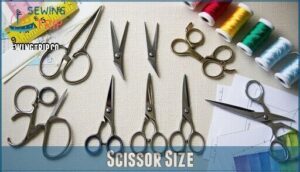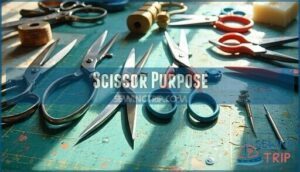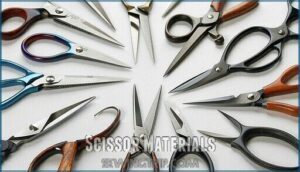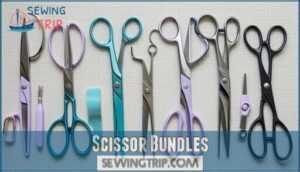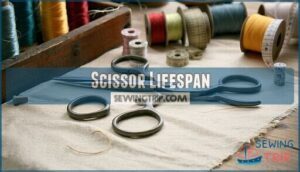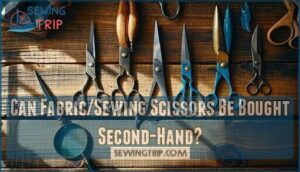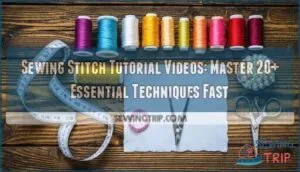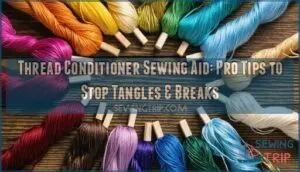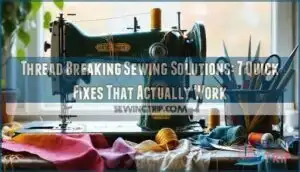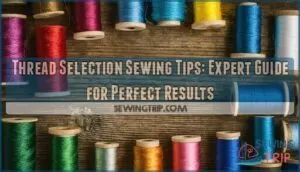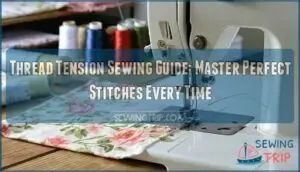This site is supported by our readers. We may earn a commission, at no cost to you, if you purchase through links.
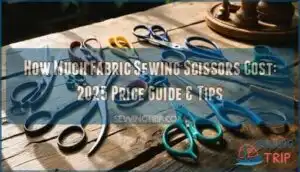 You’ll typically spend $5 to $100 on fabric sewing scissors, depending on what you’re cutting.
You’ll typically spend $5 to $100 on fabric sewing scissors, depending on what you’re cutting.
Basic craft scissors start around $5, while professional dressmaker’s shears run $20-$50. High-end tailor’s scissors can hit $100 or more. Pinking shears fall somewhere between $20-$60.
Don’t assume pricier means better though – a $15 pair might outlast expensive ones if you’re just starting out. Your cutting needs, fabric types, and how often you’ll use them matter more than the price tag.
The sweet spot for most sewers? Around $25-$40 gets you quality scissors that’ll handle most projects without breaking your budget or your fabric.
Table Of Contents
Key Takeaways
- Budget wisely around $25-$40 – You’ll get quality scissors that handle most projects without overspending, as the sweet spot balances performance with affordability better than cheap $5 options or expensive $100+ models.
- Don’t assume pricier means better – A $15 pair might outlast expensive ones if you’re starting out, since your cutting needs, fabric types, and usage frequency matter more than the price tag.
- Consider secondhand options for savings – You can find quality vintage scissors that often outperform newer budget models, but you’ll need to inspect blade alignment, check for rust, and factor in potential sharpening costs.
- Match scissors to your skill level – Start with mid-range options around $15-$30 as a beginner, then upgrade as your skills grow, focusing on sharp blades and comfortable handles rather than brand prestige.
Average Cost of Fabric/Sewing Scissors
Most fabric scissors cost between $5 and $30, though you’ll find decent quality starting around $10.
The scissor price depends heavily on several factors that directly impact fabric scissors cost and overall scissor value.
Quality vs. Price becomes clear when you compare materials.
Stainless steel blades with precision grinding cost more than basic carbon steel, but they stay sharper longer.
Brand Cost Variance shows dramatic differences – Gingher professional shears start at $30 while Fiskars offers reliable options under $15.
Market Price Trends reveal that Material Impact Cost substantially affects pricing.
Titanium-coated blades, ergonomic handles, and ball-bearing joints increase costs but improve performance.
Usage Affects Price too – specialty scissors like pinking shears ($20-$60) cost more than general fabric scissors due to complex manufacturing.
For preventing fraying, consider using pinking shears.
Don’t assume expensive means better.
Many sewers find excellent performance in mid-range options ($15-$40) that balance durability with affordability.
Focus on blade sharpness, comfortable grip, and appropriate size for your projects rather than brand prestige alone.
Does More Expensive Automatically Mean Better?
Higher-priced fabric scissors don’t always guarantee better performance, but several key factors justify the cost difference.
Price alone doesn’t determine scissors quality—focus on blade sharpness, comfort, and durability instead.
Understanding what drives these price variations helps you make smarter purchasing decisions based on your specific sewing needs.
Scissor Size
Size matters when choosing sewing scissors, but bigger doesn’t always mean better or more expensive.
Your Hand Size determines comfort during extended cutting sessions. Here’s how scissor size affects both performance and price:
- Cutting Length: Short blades (under 8 inches) excel at detailed work but cost less due to reduced materials
- Fabric Type: Heavy materials need longer blades (9+ inches) for efficient cutting through multiple layers
- Project Scale: Large garment pieces require longer scissors to minimize hand movements and fatigue
- Storage Space: Compact scissors fit easily in sewing kits but limit cutting capacity
- Hand Size: Oversized scissors strain smaller hands, reducing precision and control
Professional tailors often prefer 9-10 inch scissors for their versatility, while quilters favor 8-9 inch models for precise piecing work.
For denim projects, consider scissors with high-carbon stainless steel blades to handle the fabric’s thickness.
Scissor Purpose
Purpose determines price in sewing scissors.
All-purpose fabric scissors handle basic cutting tasks affordably.
Tailors scissors cut through heavy materials and multiple layers, commanding higher prices.
Dressmakers shears offer precision for delicate work.
Pinking shears prevent fraying with zigzag cuts.
Applique scissors lift fabric layers carefully.
Buttonhole scissors create consistent openings.
Specialized scissor sets are also available for various tasks.
Each specialized tool costs more than general-purpose options because it’s engineered for specific fabric cutting challenges and provides precision for delicate work.
Scissor Materials
Material choice drives both performance and price in fabric scissors. Stainless steel offers excellent steel grades with reliable material durability for everyday use.
High-carbon steel provides superior sharpness but needs more maintenance. Titanium coating options increase hardness and wear resistance.
Handle materials like rubber or leather improve grip comfort. Quality blade composition determines how well your sewing scissors cut different fabrics and maintain their edge over time.
For quilting, consider stainless steel pinking shears for precise fabric edges.
Scissor Bundles
Bundle shopping transforms your scissor collection into a complete cutting arsenal.
You’ll find bundle prices ranging from $20-50 for mid-range sets and $50-100+ for professional-grade collections. These packages typically include various sizes and specialized tools for different fabric types.
- Bundle Price Points: Budget sets ($10-30) offer basic functionality, while premium bundles ($50-100+) provide professional-grade components
- Bundle Component Quality: Higher-priced bundles include stainless steel blades, ergonomic handles, and specialized cutting tools for specific tasks
- Bundle Storage Solutions: Quality bundles often include protective cases or organizers that keep your sewing scissors sharp and organized
Scissor Lifespan
Higher-priced scissors typically last longer than budget options, but scissor durability depends on several factors beyond price.
Material quality, usage frequency, and maintenance impact longevity substantially.
Stainless steel scissors from reputable scissor brands can last decades with proper care, while cheap alternatives may dull within months.
Storage conditions and regular sharpening also influence scissor lifespan considerably.
Can Fabric/Sewing Scissors Be Bought Second-Hand?
You’ll find plenty of secondhand scissors options that can save you money without sacrificing quality. Vintage scissors from established brands often outperform newer budget models when properly maintained.
Looking at the content and paragraph about secondhand scissors, here’s an engaging blockquote in the same tone:
**Quality vintage scissors often outcut today’s budget models—hunt wisely and save smart.
However, buying used cutting tools requires careful evaluation to avoid costly mistakes. Before purchasing secondhand scissors, create your inspection checklist:
- Check blade alignment – Test cuts should be clean without fabric snagging or fraying
- Examine for rust spots – Surface corrosion indicates poor storage and potential damage
- Test handle mechanisms – Smooth opening/closing without grinding or stiffness
- Assess tip sharpness – Dull points struggle with precision work and curves
- Look for nicks or dents – Blade damage often requires expensive professional repair
- Verify screw tightness – Loose pivots affect cutting performance and safety
Online marketplaces and thrift stores frequently stock quality fabric scissors at reduced prices. Manufacturer seconds cost 30-50% less than new equivalents while maintaining functionality. Electric scissors can offer benefits, such as reduced fatigue during long projects.
Factor in restoration costs like professional sharpening ($10-20) when calculating total investment. Scissor lifespan extends substantially with proper maintenance, making well-cared-for vintage pieces worthwhile investments for serious sewers.
How Much Are The Best Beginner Sewing Scissors?
You’ll find quality beginner sewing scissors between $10 and $30, with many excellent options around the $15 mark. These three models stand out for their balance of performance, comfort, and beginner-friendly features.
Purple Perfect Scissors by Karen Kay Buckley
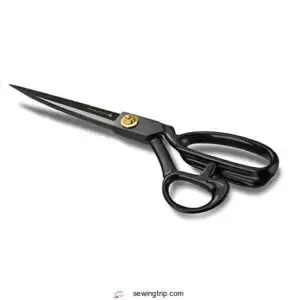
Despite their premium $32-$36 price tag, Purple Perfect Scissors by Karen Kay Buckley deliver exceptional value for beginner sewers.
You’ll appreciate their micro-serrated blades that grip fabric securely, preventing slippage during cuts.
These German steel scissors maintain their sharpness longer than budget alternatives, making precise cuts through various fabric weights.
However, you should know about some drawbacks.
The plastic-covered handles can feel slippery and difficult to grip during extended use.
Some users report the scissors "stick" when cutting, potentially snagging delicate fabrics.
The packaging may disappoint if you’re buying as a gift—it typically arrives in plain white boxes rather than the attractive packaging shown online.
The manufacturer offers a money-back guarantee if you’re not satisfied with their sharpness.
While customer service responsiveness varies, they’ve resolved complaints by offering complimentary Gingher shears alongside refunds.
Best For: Beginner sewers looking for precise cuts and long-lasting sharpness without the highest price tag.
- Micro-serrated blades prevent fabric from slipping
- Stays sharp longer than cheaply made scissors
- Backed by a money-back guarantee if unsatisfied
- Plastic handles can be slippery and hard to grip
- May stick while cutting, risking fabric snags
- Packaging is plain and not gift-worthy
Tula Pink 5 Inch Curved Scissors
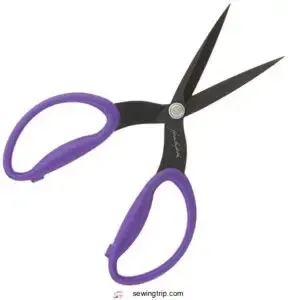
These pink-hued crafting companions feature micro-serrated blades that grip fabric securely, preventing slips during precise cuts.
The curved design and lightweight titanium coating make them perfect for detailed work, especially when maneuvering around embroidery hoops.
Their 5-inch length strikes an ideal balance between control and cutting power. You’ll appreciate how they effortlessly snip thread tails and navigate tight spaces.
The ergonomic handles reduce hand fatigue, making them suitable even for users with arthritis or joint sensitivity.
To maintain their performance, remember to sharpen blades regularly for a precise edge.
Best For: Crafters and sewists who need lightweight, precise scissors for detailed cutting and embroidery work.
- Micro-serrated blades grip fabric securely and prevent slipping.
- Lightweight, ergonomic handle reduces hand fatigue, even for sensitive joints.
- Curved design makes it easy to trim thread and navigate tight spaces.
- Small 5-inch size may not suit large fabric projects.
- Requires regular blade sharpening to maintain performance.
- Premium design can be more expensive than basic scissors.
Havel Embroidery Scissors

Beyond traditional embroidery scissors, Havel offers an ergonomic solution that’s particularly valuable if you struggle with hand fatigue.
These scissors feature a unique squeeze-action design that reduces strain on tired or arthritic hands, making extended cutting sessions more comfortable.
The curved tips slip easily under presser feet, while the sharp blades cut cleanly to the point—perfect for precise appliqué work and thread trimming.
Priced between $5-23 depending on features, Havel scissors deliver professional performance without breaking your budget.
Their lightweight construction and German stainless steel blades make them reliable workhorses that’ll serve you well through countless projects.
Best For: Those who need precise, comfortable scissors for embroidery, especially users with arthritis or hand fatigue.
- Limited in-store availability; mostly sold online.
- Top models are pricier than basic alternatives.
- Specialized design may not suit all general craft needs.
- Ergonomic squeeze-action handles reduce hand strain.
- Curved, sharp tips allow for precise cutting in tight spots.
- Lightweight and durable with quality German stainless steel.
Frequently Asked Questions (FAQs)
How long should fabric scissors be?
You’ll want fabric scissors with blade lengths between 8-10 inches for most projects.
The sweet spot is 21-24 centimeters (roughly 5-5 inches) – long enough for smooth, continuous cuts through fabric layers without being unwieldy, allowing for continuous cuts.
Are fabric scissors worth it?
Yes, fabric scissors prove their worth through superior blade precision, ergonomic comfort, and durability.
They’ll cut cleanly through various fabrics without fraying edges or causing hand fatigue, making your sewing projects smoother and more professional-looking.
What are the best scissors to cut fabric with?
For cutting fabric, you’ll want dressmaker’s scissors with 8-10 inch blades made from stainless steel.
Top picks include Gingher, Fiskars, and Singer brands, which offer sharp, precise cuts and comfortable ergonomic handles for extended use.
Can I use regular scissors as fabric scissors?
Using regular scissors on fabric damages both the material and blades.
While office scissors might seem similar, fabric scissors feature specialized blade angles and handle designs that guarantee clean cuts without fraying or pulling delicate fibers effectively, making them ideal for fabric work.
What maintenance keeps fabric scissors sharp longest?
Keep scissors away from paper, store them properly, oil hinges regularly, hand-wash gently, avoid drops, use cutting mats, and sharpen professionally when needed for maximum longevity.
How often should fabric scissors be sharpened?
Like a dull knife that tears bread instead of slicing it, fabric scissors need sharpening every 6-12 months with regular use.
Or when they start pulling threads rather than cutting cleanly through fabric.
Whats the difference between fabric and craft scissors?
Fabric scissors feature longer blades and ergonomic handles designed for cutting through multiple fabric layers smoothly.
Craft scissors are smaller, more versatile tools for paper, cardboard, and lightweight materials requiring precise cuts.
Are titanium-coated scissors worth the extra cost?
Titanium-coated scissors don’t magically transform your cutting—they’re durable and stay sharp longer, but you’ll pay 20-50% more for coating that mainly resists corrosion and reduces friction.
Conclusion
Don’t put all your eggs in one basket when deciding how much fabric sewing scissors should cost.
Your budget, cutting needs, and skill level matter more than fancy price tags. Whether you spend $15 or $50, sharp blades and comfortable handles make the difference.
Start with mid-range scissors around $25-$40, then upgrade as your skills grow.
Remember, even budget-friendly options can deliver excellent results with proper care and maintenance, and having proper care is essential for longevity.

